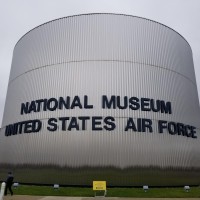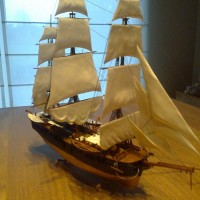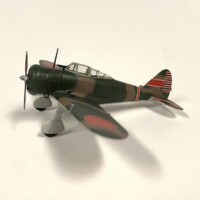Fairchild F.91 “Baby Clipper”: Adventure... wherever you look!
Although only seven examples of this extremely attractive and highly capable flying boat were built from the mid-1930s onwards, each of these flying boats, designed as “flying boat airliners”, was to have a short but all the more adventurous operational history. One of the seven “Baby Clippers” went to China, Australia and Spain, two each to Brazil and Japan and one, the one shown here in the model, to North Africa. They were all only used for a short time: by the mid-1940s, all Fairchild F.91s had either been scrapped, had broken down or had been lost after crashes.
The Fairchild F.91 “Baby Clipper”: seven adventurous biographies.
The model was originally ordered from Fairchild in the early 1930s by Pan American Airways, who needed a flying boat airliner optimized for the flight routes along the Yangtze and Amazon rivers - adventure was in the F.91's genes, so to speak!
Fairchild supplied a modern all-metal construction with high-set wings and a Pratt & Whitney R-1690 Hornet engine positioned in a nacelle high above the fuselage. This peculiar arrangement was not unprecedented and had already proved its worth; it is not for nothing that the configuration of the F.91 is reminiscent of flying boat designs such as the Beriew Be-4. The prototype of the new aircraft, soon to be nicknamed the “Baby Clipper”, took off for the first time on April 5, 1935.
After delivery of the first two of a total of four aircraft ordered, however, Pan Am changed its mind and stopped the purchase, as the Yangtze was no longer being flown to. The two aircraft went to Panair do Brasil, an offshoot of Pan Am, where they broke down in 1941 and 1945 respectively after several years of intensive flight operations and were then scrapped. Two further F.91s were sold to Far East Asia, where they were evaluated by the Imperial Japanese Navy. After the first F.91 was lost during testing, a second was purchased as a replacement. However, the interest does not seem to have been too great, so that neither a purchase nor a license acquisition followed.
The first built Fairchild F.91 itself came to Spain by adventurous means during the Civil War. Although the flying boat was originally purchased by the Republicans, it was ultimately flown by the Nationalists. After the end of the Civil War, it was scrapped in 1941.
A special F.91 was purchased and equipped by the NYC Museum of Natural History in 1936 to serve as an expedition aircraft: the naturalist Richard Archbold used the aptly named ‘Jungle Clipper' for his expedition to the completely unexplored and unknown areas of Papua New Guinea - but only for the first year of the two-year research trip: the ‘Jungle Clipper' fell victim to a tropical storm in 1936. This particular aircraft is well documented in photos and, in my opinion, with its sleek blue and red paintwork, is one of the most beautiful editions of this already beautifully designed flying boat!
Last but not least: Fairchild F.91 /NR16690/ HK832 (RAF)
The Fairchild F.91 shown here in the model with the serial number NR16690 completes the number of seven ‘Baby Clippers' built. It also has an exciting story to tell: purchased from Fairchild by the American industrialist, inventor, racing driver and philanthropist Garfield Wood - a colourful, interesting personality whose humanitarian commitment can only be briefly mentioned here - it was given to the British-American Ambulance Corps (BAAC ). This was an organisation of Americans living in Great Britain who financed the purchase and use of rescue vehicles and ambulances from private funds during the war. Today we would probably call it a humanitarian NGO.
NR16690 was eventually handed over by the BAAC to the Royal Air Force, which used it with the registration HK832 from November 1941 in North Africa for sea rescue and humanitarian missions. Available photos show several changes of livery, some of which appear very weathered on the photographic material. With the camouflage of - probably - ‘Earth Brown', ‘Middlestone' and ‘Azur' shown here, it flew numerous rescue missions as part of the RAF's Sea Rescue Flight from its base in Heliopolis, Egypt. But this aircraft was not to survive the war either: it sank on 17 May 1943 after hitting an object floating in the sea off Benghazi and sprung a leak.
Kit and construction process
For this edition of the F.91, Azur uses the Sword kit moulds from 2001. In the preceding sketch of the operational history of the seven F.91s, I often used the word ‘adventurous': unfortunately, this term is also appropriate when describing the components and the construction process!
Little light...
I was pleased with the resin parts for the engine block and some areas of the interior. These also include beautifully moulded resin seats and two rudder horns; the latter, however, were so finely cast and at the same time covered with so much fish skin that they broke beyond repair when I cut them off and cleaned them up.
I also have positive memories of the appropriately subtle and high-quality surface textures. However, this concludes the laudatory part of my review.
...and lots of shade!
The rest that followed was, to put it bluntly, simply dreadful. I would like to spare myself and the reader the enumeration of the numerous inconsistencies and unsightly challenges, spread the cloak of silence over them and instead let the enclosed construction photos speak for themselves.
However, the fact that the fuselage windows were unusable resulted in a new experience for me: I cut the windows out of thin transparent film and carefully fitted them into the openings in the fuselage. They were glued in place with a few drops of white glue. As I discovered, this can at least be done so well that the result looks much better than anything I could have achieved with the moulded original window parts. In future, I will not hesitate to use this method for subsequent building experiences with unsightly transparent parts.
I also replaced the glazing above the cockpit. Although the component - a vacuum-formed canopy - was well made, the ravages of time had given it a distinct yellow colour, so a replacement had to be found. Here, too, a new experience awaited me: the search for a replacement gave me the opportunity to finally get serious about my long-cherished plan to vacuum deep-draw it myself. After a few attempts, I was able to achieve such a good result with a newly purchased vacuum forming machine that I could install it with a clear conscience. To illustrate this process, I would again like to refer you to the pictures of the construction process.
I would also like to mention that all the numerous struts, tensioning wires, aerials and small parts such as the mast with the Venturi tubes mounted on it on the top of the engine nacelle are not mentioned in the instructions, nor can the corresponding parts be found in the kit. As a result, all the detailed moulds mentioned come from my model research respectively my material fund.
Conclusion
As the previous words suggest, building the Fairchild F.91 was a challenging experience, during which I often wondered whether all that time should be spent on more rewarding projects. However, I will also remember it as a project where I was forced to leave my ‘comfort zone' and try something new. In particular, the skills around vacuum forming, where I now have at least one foot in the door, will accompany me on subsequent modelling adventures!






























Wow what an amazing result, I'm no aviation expert but I thought I was familiar with most WW2 birds so when you see something totally new is fascinating especially in RAF markings I love it Roland, but not enough to attempt one !
Well done.
That's an amazing build, Roland @rosachsenhofer
Thanks for sharing the history of the unusually designed aircraft.
Wowzers, Roland!
Looking at those leading edges and the other joints would have had me place this build on the shelf.
The hanger photos look amazing!
Great work on the canopy, very nice.
Great job! That engine placement looks rather strange, but I guess it worked.
Man, lots of elbow grease applied to this one! Beautiful outcome of an unusual aircraft - that engine mount really draws your attention!
Awesome job, Roland! What an amazing result from the challenging Azur kit!
Congratulations, also for the wonderful and very informative writeup!
Now that’s a new one on me! Never realized one of these went to war with the RAF. Beautiful model.
You did a good job of beating this kit into submission.
Beautiful work Roland. I started my build of this same kit last year, it is about 75% complete. I ran out of my mojo and one day I need to build myself up to get it done. Your effort put into your build shows with the end results, great job!
Excellent result from all that fine work. That's one we don't see every day!
Roland, you always build the most unusual and interesting aircraft into beautiful scale models! Thank you for that as you really broadened my airplane knowledge. This rare bird is yet another example of your stellar work and research @rosachsenhofer!
Thank you for that as you really broadened my airplane knowledge. This rare bird is yet another example of your stellar work and research @rosachsenhofer! 
Great job, Roland